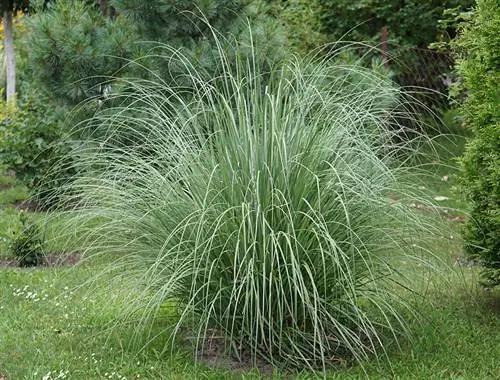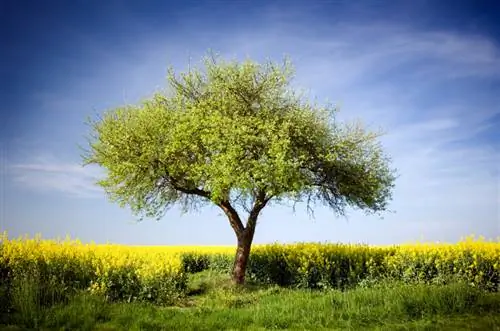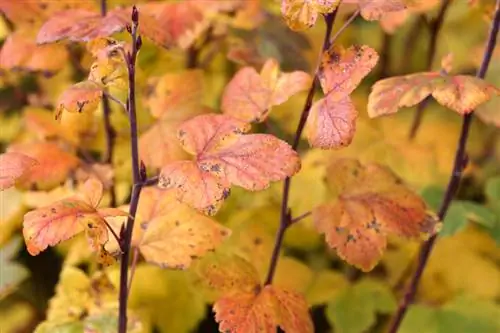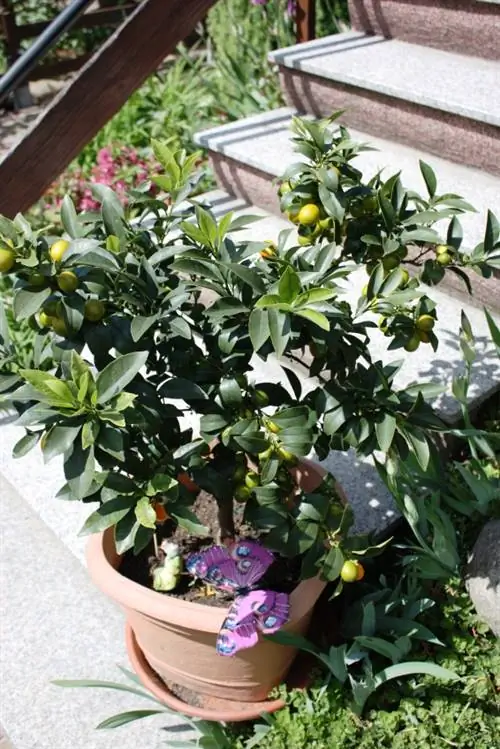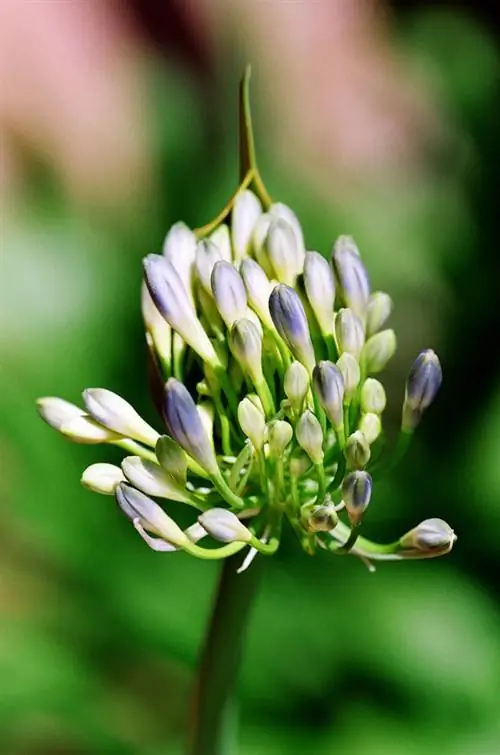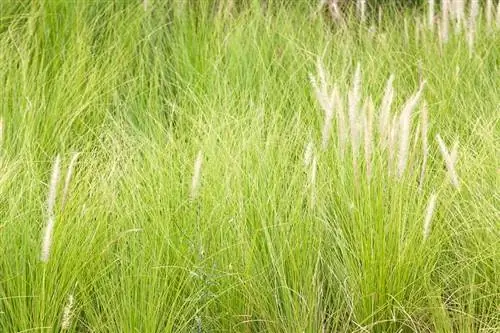- Author admin [email protected].
- Public 2023-12-16 16:46.
- Last modified 2025-06-01 06:02.
Your pampas grass isn't blooming? No worries! The fronds of pampas grass do not appear until late in the year. In addition to the time of year, it can also be due to a number of other reasons, such as the location or care errors. Sometimes the plant is male and naturally has fewer of the popular fronds.

Why isn't my pampas grass blooming?
Pampas grass will not bloom if the location is too shady or cool, there is a lack of nutrients, it is pruned incorrectly or it receives too little water. Patience is important as pampas grass only blooms after two to three years.
Why doesn't pampas grass bloom?
An unsuitable location, lack of fertilizer, incorrect pruning time or insufficient water can be responsible for the lack of flowers. Some grasses only bloom from the second or third year onwards. If the plant does not bloom after years, it may be a male specimen - this does not produce any flowers.
Pampas grass does not form fronds and does not bloom
The fronds are one of the iconic properties of the ornamental grass and, even in combination with other plants, ensure that it develops its full splendor. In addition to an unsuitable location, general care can also be a cause of the lack of flowers.
Wrong location

Cortaderia selloana is a sun and heat loving plant. To develop the fronds, the plant needsseveral hours of sunshine a day and a minimum temperature of 20 degrees Celsius. The grass responds to a location that is too shady or too cool with low growth and the absence of flower fronds. In addition, the grass does not tolerate strong gusts of wind, as these lead to the blades breaking.
General care errors and solutions
The pampas grass is basically very undemanding and therefore also suitable for garden beginners. However, there are a few points to consider when it comes to care in order to provide the plant with the best possible care.
Fertilize
The nutrient requirements of ornamental grass are also very high due to its high growth rate. Aninsufficient nutrient supplywith the minerals nitrogen and phosphate leads to a significantly reduced growth height and often thelack of frondsBut excessive fertilizer supply can also lead to a lack of flowering, as the nutrients are used in large quantities for the growth of the stalks. You can find some important information about fertilizing here.
Cutting
The optimal time for pruning pampas grass is spring. However, great caution must be exercised when pruning, as only the old shoots may be shortened. Pruning the newly sprouted stems usually results in the absence of decorative flower fronds. In addition, theshoots should be shortened to a maximum of 20 centimeters above the ground.
Water balance and drought
Pampas grass generally tolerates drought much better than waterlogging. Nevertheless, thesoil substrate should never dry out completely and should be kept evenly moist. Excessive and persistent waterlogging promotes rotting processes and, in the worst case, leads to the death of the entire plant. It is therefore advisable to check the soil regularly using a finger test and only water it when necessary. To protect the soil from drying out, especially in summer, a layer of mulch can be applied.
Soil texture
In nature, pampas grass is mainly found in steppes that have alluvial soils. These are characterized above all byhigh water permeability and depth, which allows almostno waterlogging. In order to adapt the soil conditions in this country to the natural conditions, the planting site should be well prepared before planting.
- Dig a sufficiently large planting hole
- loose up the bottom layer additionally
- mix the excavated soil with compost or horn shavings and fill it in
- Insert seedling, stabilize with mixture and press firmly
Pampas grass in the pot doesn't bloom
Specimens of ornamental grass transplanted into containers are far moresensitive than their relatives transplanted outdoors in relation to a number of factors. In addition to choosing the right planter, fluid balance plays a more important role.
Wrong location

Similar to the specimens transplanted outdoors, the container plant should be located in a sunny and warm place. Using a rolling board that is placed underneath the pot, you can move the planter to a suitable location at any time.
General care errors and solutions
The preparation of the planter, like the preparation of the planting hole, requires meticulous preparation in order to prevent the pampas grass's greatest enemy, waterlogging. The most basic information is also compiled here for you.
Substrate and container
There are a few tips to keep in mind when caring for Cortaderia selloana in a pot. A filling volume that is too low leads to reduced root development, which in turn affects overall growth. In addition to the pot size, the composition of the substrate is also very important.
The following structure has proven itself in practice:
- Choose a planter with a capacity of at least 40, preferably 50 liters
- Fill the lower area with expanded clay (€19.00 on Amazon) or gravel
- fill remaining volume with grass soil or a soil-sand mixture
The grass soil already contains all the important components for pot planting. This eliminates the need to mix sand, compost and soil.
Cutting
Pampas grasses transplanted into pots should only be cut in spring. The lush fronds that remain provide natural frost protection for the heart of the plant over the winter. In these latitudes it is often not completely hardy. What you should also pay attention to when pruning is explained in this article.
Water balance and drought
An inadequate drainage layer and an overly compacted substrate result in increased water retention. This in turn can promote root rot, which can lead to the death of the plant if treated too late.
In contrast, drought also represents an increased risk for potted plants. Due to the limited amount of substrate and the compressed root ball, there is a risk of complete drying out, especially in summer, which is also urgently to be avoided. Cyclic monitoring of the moisture content is therefore essential.
Pampas grass blossom
Identifying flowers - male and female plants
The perennial is a dioecious plant and occurs naturally in male and female forms. Fundamentally, the different sexes do not differ from each other, only the number of flowers formed differs. While female pampas grasses develop dense and full fronds, male specimens have a much smaller number. It is therefore advisable to pay attention to the corresponding gender when purchasing and not to sow gender-unspecific seeds.
Flowering time of pampas grass
How fast does ornamental grass grow, when does pampas grass bloom and what to do if your pampas grass doesn't bloom?
The flowering period of pampas grass often only beginsin late summer or autumn As a rule, there is hardly any change to the plant until May. However, this is not a flaw in the plant, but rather due to the original vegetation and growth period. The individual phases are as follows:
- April to June: Formation of new shoots and height growth
- July to August: Final height almost completely reached, first flower buds visible
- From September: comprehensive training of the fronds completed
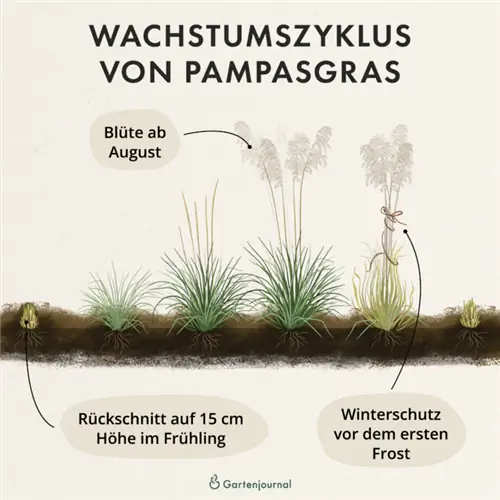
The first flower after planting
Even if the pampas grass quickly gains height, you still need to be patient until the first flowers are visible. As a rule, thefirst flowers appear after two to three years.
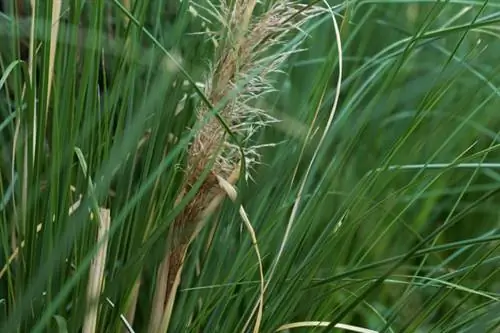
FAQ
When does pampas grass sprout?
The sprouting of Cortaderia selloana usually only begins in late spring in May.
When does pampas grass grow fronds?
The fronds are only formed in the last phase of the growth cycle and can therefore only be seen in their full glory in autumn.
How do I make pampas grass bloom?
In addition to the right location, the perennial requires optimal care in the areas of substrate density, fertilization and irrigation in order to flower.
How long does pampas grass take to bloom?
It often takes two to three years until the first flowering occurs. Afterwards, with good care, an annual flowering can be expected.
Why doesn't pampas grass bloom?
The reasons for the failure to bloom can be varied. Most often, however, this is due to inadequate care, an unsuitable location or the wrong plant sex.

